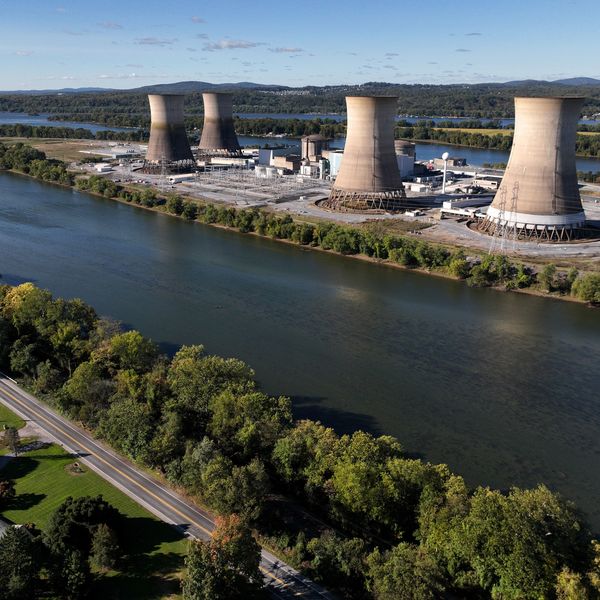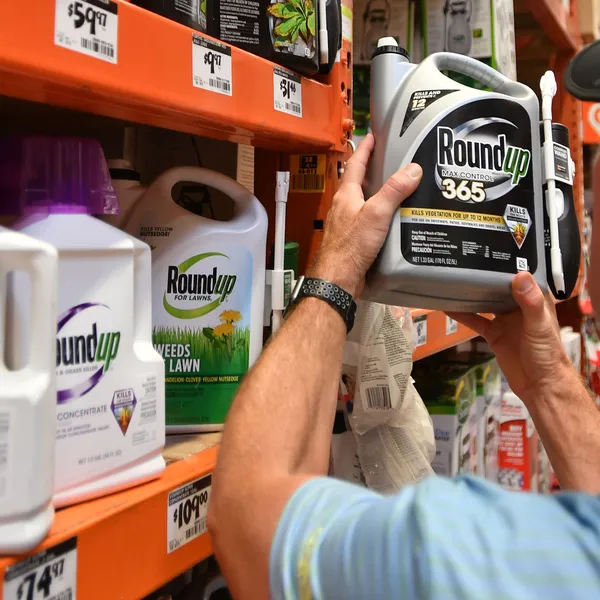New Report Urges Research Into Environmental Causes of Breast Cancer
'We are all exposed to a cocktail of carcinogens and endocrine disruptors every day that puts us at greater risk for breast cancer, and we need to prioritize and invest in identifying and preventing exposures”: Breast Cancer Fund head
A federal report released Tuesday urges more research into the environmental causes of breast cancer, including the "cocktail of carcinogens and endocrine disruptors" people are exposed to every day.
The report is the culmination of over two years of work from a federal committee, the Interagency Breast Cancer and Environmental Research Coordinating Committee (IBCERCC), charged in 2008 with looking at the current state of breast cancer and environment research, and was led by Jeanne Rizzo, president and CEO of the Breast Cancer Fund, Dr. Michele Forman from the University of Texas at Austin and Dr. Michael Gould from the University of Wisconsin.
"Prevention is the key to reducing the burden of breast cancer," the report states, and most breast cancers occur in people with no family history, implicating environmental factors in the disease. Yet research into environmental causes of breast cancer is woefully underfunded. From the report:
at most, 10 to 11 percent of breast cancer research projects funded by the National Institutes of Health (NIH) and the U.S. Department of Defense (DoD) focus on environmental health. No other federal agency supports substantial research on the environmental causes of breast cancer
This lack of funding is noteworthy is given the "cocktail of chemicals" people are regularly exposed to. The report states that of the over 84,000 synthetic chemicals registered by the EPA for commercial use, at most, 2 percent have been tested for carcinogenicity.
Apart from the possible carcinogenic chemicals, the report states that "large gaps continue to exist in the understanding of breast cancer risk" with endocrine-disrupting chemicals like BPA, the pesticide atrazine and phthalates.
"This report demonstrates what the Breast Cancer Fund has been saying for years. We are all exposed to a cocktail of carcinogens and endocrine disruptors every day that puts us at greater risk for breast cancer, and we need to prioritize and invest in identifying and preventing exposures," said Rizzo.
"There is mounting evidence that chemical and physical agents play a role in breast cancer, particularly when exposures are assessed carefully across the life span, from the prenatal period onward," adds Sheila Zahm, former deputy director of the Division of Cancer Epidemiology and Genetics at the National Cancer Institute.
Saying the report should be a "call to action," IBCERCC chair Forman stated, "We can no longer ignore the major gaps in understanding the role of the environment in breast cancer, because we are constantly exposed to combinations of chemicals without knowing whether they could make one at risk for breast cancer."
"This report is intended to set the stage for a strategic plan in much the same way the 1964 surgeon general's report on smoking tobacco changed how we thought about lung cancer risk," stated Forman.
Rizzo adds that a move "to prioritize and invest in identifying and preventing exposures...may be the key to preventing many people from ever having to get the devastating diagnosis."
Read the report here.
An Urgent Message From Our Co-Founder
Dear Common Dreams reader, The U.S. is on a fast track to authoritarianism like nothing I've ever seen. Meanwhile, corporate news outlets are utterly capitulating to Trump, twisting their coverage to avoid drawing his ire while lining up to stuff cash in his pockets. That's why I believe that Common Dreams is doing the best and most consequential reporting that we've ever done. Our small but mighty team is a progressive reporting powerhouse, covering the news every day that the corporate media never will. Our mission has always been simple: To inform. To inspire. And to ignite change for the common good. Now here's the key piece that I want all our readers to understand: None of this would be possible without your financial support. That's not just some fundraising cliche. It's the absolute and literal truth. We don't accept corporate advertising and never will. We don't have a paywall because we don't think people should be blocked from critical news based on their ability to pay. Everything we do is funded by the donations of readers like you. Will you donate now to help power the nonprofit, independent reporting of Common Dreams? Thank you for being a vital member of our community. Together, we can keep independent journalism alive when it’s needed most. - Craig Brown, Co-founder |
A federal report released Tuesday urges more research into the environmental causes of breast cancer, including the "cocktail of carcinogens and endocrine disruptors" people are exposed to every day.
The report is the culmination of over two years of work from a federal committee, the Interagency Breast Cancer and Environmental Research Coordinating Committee (IBCERCC), charged in 2008 with looking at the current state of breast cancer and environment research, and was led by Jeanne Rizzo, president and CEO of the Breast Cancer Fund, Dr. Michele Forman from the University of Texas at Austin and Dr. Michael Gould from the University of Wisconsin.
"Prevention is the key to reducing the burden of breast cancer," the report states, and most breast cancers occur in people with no family history, implicating environmental factors in the disease. Yet research into environmental causes of breast cancer is woefully underfunded. From the report:
at most, 10 to 11 percent of breast cancer research projects funded by the National Institutes of Health (NIH) and the U.S. Department of Defense (DoD) focus on environmental health. No other federal agency supports substantial research on the environmental causes of breast cancer
This lack of funding is noteworthy is given the "cocktail of chemicals" people are regularly exposed to. The report states that of the over 84,000 synthetic chemicals registered by the EPA for commercial use, at most, 2 percent have been tested for carcinogenicity.
Apart from the possible carcinogenic chemicals, the report states that "large gaps continue to exist in the understanding of breast cancer risk" with endocrine-disrupting chemicals like BPA, the pesticide atrazine and phthalates.
"This report demonstrates what the Breast Cancer Fund has been saying for years. We are all exposed to a cocktail of carcinogens and endocrine disruptors every day that puts us at greater risk for breast cancer, and we need to prioritize and invest in identifying and preventing exposures," said Rizzo.
"There is mounting evidence that chemical and physical agents play a role in breast cancer, particularly when exposures are assessed carefully across the life span, from the prenatal period onward," adds Sheila Zahm, former deputy director of the Division of Cancer Epidemiology and Genetics at the National Cancer Institute.
Saying the report should be a "call to action," IBCERCC chair Forman stated, "We can no longer ignore the major gaps in understanding the role of the environment in breast cancer, because we are constantly exposed to combinations of chemicals without knowing whether they could make one at risk for breast cancer."
"This report is intended to set the stage for a strategic plan in much the same way the 1964 surgeon general's report on smoking tobacco changed how we thought about lung cancer risk," stated Forman.
Rizzo adds that a move "to prioritize and invest in identifying and preventing exposures...may be the key to preventing many people from ever having to get the devastating diagnosis."
Read the report here.
A federal report released Tuesday urges more research into the environmental causes of breast cancer, including the "cocktail of carcinogens and endocrine disruptors" people are exposed to every day.
The report is the culmination of over two years of work from a federal committee, the Interagency Breast Cancer and Environmental Research Coordinating Committee (IBCERCC), charged in 2008 with looking at the current state of breast cancer and environment research, and was led by Jeanne Rizzo, president and CEO of the Breast Cancer Fund, Dr. Michele Forman from the University of Texas at Austin and Dr. Michael Gould from the University of Wisconsin.
"Prevention is the key to reducing the burden of breast cancer," the report states, and most breast cancers occur in people with no family history, implicating environmental factors in the disease. Yet research into environmental causes of breast cancer is woefully underfunded. From the report:
at most, 10 to 11 percent of breast cancer research projects funded by the National Institutes of Health (NIH) and the U.S. Department of Defense (DoD) focus on environmental health. No other federal agency supports substantial research on the environmental causes of breast cancer
This lack of funding is noteworthy is given the "cocktail of chemicals" people are regularly exposed to. The report states that of the over 84,000 synthetic chemicals registered by the EPA for commercial use, at most, 2 percent have been tested for carcinogenicity.
Apart from the possible carcinogenic chemicals, the report states that "large gaps continue to exist in the understanding of breast cancer risk" with endocrine-disrupting chemicals like BPA, the pesticide atrazine and phthalates.
"This report demonstrates what the Breast Cancer Fund has been saying for years. We are all exposed to a cocktail of carcinogens and endocrine disruptors every day that puts us at greater risk for breast cancer, and we need to prioritize and invest in identifying and preventing exposures," said Rizzo.
"There is mounting evidence that chemical and physical agents play a role in breast cancer, particularly when exposures are assessed carefully across the life span, from the prenatal period onward," adds Sheila Zahm, former deputy director of the Division of Cancer Epidemiology and Genetics at the National Cancer Institute.
Saying the report should be a "call to action," IBCERCC chair Forman stated, "We can no longer ignore the major gaps in understanding the role of the environment in breast cancer, because we are constantly exposed to combinations of chemicals without knowing whether they could make one at risk for breast cancer."
"This report is intended to set the stage for a strategic plan in much the same way the 1964 surgeon general's report on smoking tobacco changed how we thought about lung cancer risk," stated Forman.
Rizzo adds that a move "to prioritize and invest in identifying and preventing exposures...may be the key to preventing many people from ever having to get the devastating diagnosis."
Read the report here.

